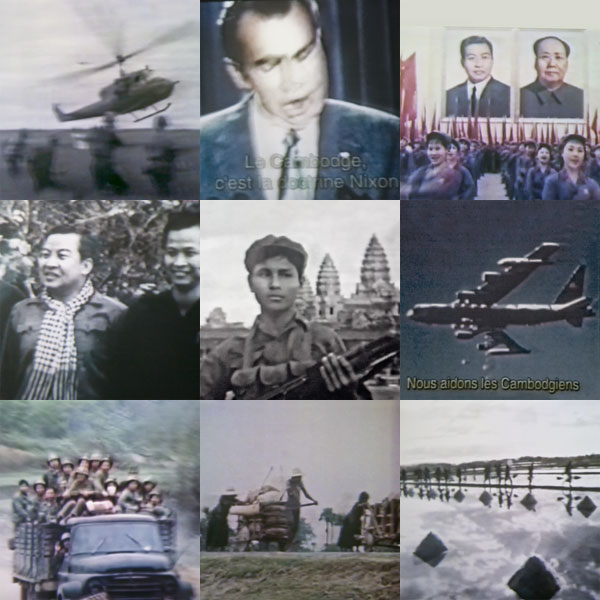 Nine-Square History: This composite image outlines a pictographic, and much abbreviated, historical context of contemporary Cambodia during and immediately after the Vietnam War. Read the accompanying wall text here.
Nine-Square History: This composite image outlines a pictographic, and much abbreviated, historical context of contemporary Cambodia during and immediately after the Vietnam War. Read the accompanying wall text here.
- Bone Box — Tonle Bati, Cambodia, 2005 (triptych)
- Sticky Rice Offering with Red Army Ants — Rural eastern Cambodia, 2006 (single image)
- Bassac Squatter Village — Phnom Penh, Cambodia, 2006 (triptych)
- Squatter Hut and Destroyed Hut — Phnom Penh, Cambodia, 2006 (diptych)
- Tuol Sleng Prison Cells — Phnom Penh, Cambodia, 2006 (diptych)
- Tuol Sleng Prison Yard — Phnom Penh, Cambodia, 2005 (triptych)
- Two Beds — Rural eastern Cambodia, 2006 (diptych)
- Fishing Huts — Battambang River, western Cambodia, 2006 (triptych)
- Hut with Flag — Battambang River, western Cambodia, 2006 (single image)
Dark Dream: Cambodia in the Wake of War
During the Vietnam War, the United States military began a relentless campaign of carpet-bombing over eastern Cambodia, decimating hundreds of thousands of innocent Cambodians. Radicalized to the extreme, in part because of the American bombing campaign, the fledgling Khmer Rouge Communist insurgents were organizing in the Cambodian jungle. In 1979, during the end of the Vietnam War, the Khmer Rouge gained control of Cambodia and began their campaign to bring the population back to an agrarian culture of subsistence farming, “pure” from Western influences. Cambodians were told it was the “Year Zero”: a new beginning with no past and no future.
It was the beginning of the genocide known as the Killing Fields. During the next four years, nearly two million Cambodians, a quarter of the population, would lose their lives through systematic mass murder and from starvation and disease. When the Khmer Rouge were overthrown by the Vietnamese in 1979, the country sank into nineteen years of civil war which ended in 1998 with the death of Khmer Rouge leader, Pol Pot. When the country slowly reopened to the world, all systems of civil society such as family structures, villages and towns, schools and universities, hospitals, art, music and dance, religion, a monetary system, television, radio and newspapers, along with any semblance of a functional government, had disappeared.
Although it has stabilized somewhat as a nation and is finally beginning genocide tribunals, the past still casts a long shadow over Cambodia, with perpetrators and surviving victims living side by side. Social, psychological, political, and environmental decimation remains much in evidence. The ravages of countless bombings and thousands of mine fields still leave their mark. Extreme poverty is a matter of course and an internally displaced population of wanderers continually moves from place to place in search of shelter and safety.
Despite the terrible hardships, a palpable gentleness pervades daily activities. Kindness, and Buddhist tranquility abound. Myriads of small shrines house offerings to ghosts, ancestors, ancient spirits and gigantic, sacred trees. Stone temples sit silent, overgrown and magical, like hallucinations in the jungle.
Cambodia, it seems, is a place where contradictions abound. It is this complex layering, this irreconcilable conflict of hope and loss, which has motivated me to develop a series of projects about this place.
“Dark Dream” is composed of photographs taken in Cambodia over the course of five years, (2005-09.) The images are of inhabited and abandoned spaces, both rural and urban. Deserted Khmer Rouge prisons and training camps, the remnants of mass graves, squatter communities and river huts are the places which reflect life still darkened by shadows of the recent past. As juxtapositions of multiple images, the panels construct a visual continuum, in which each image functions as part of a larger, more complex narrative; a story specific to Cambodia, but also one symbolic of the aftermath of conflicts the world over.









